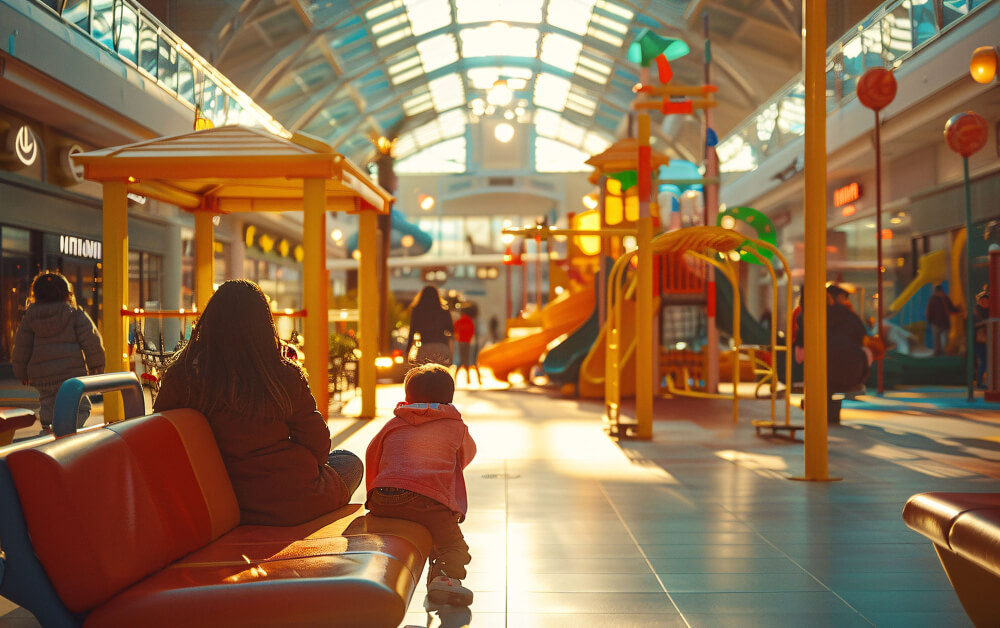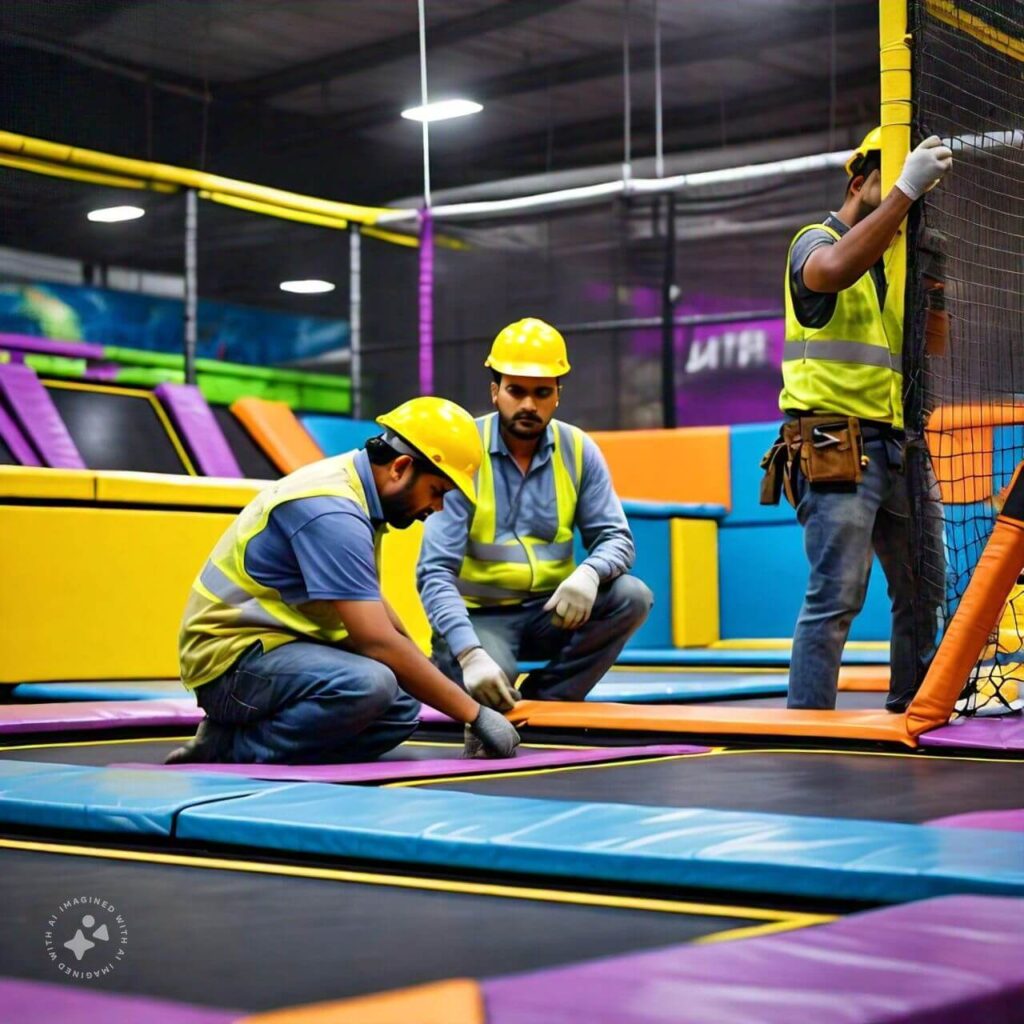Are you looking to create an exciting play area that will keep kids entertained for hours? We’ve got you covered! Indoor playgrounds and trampoline parks have become increasingly popular, offering a safe and fun environment for children to burn off energy and develop crucial motor skills. As experts in the field, we understand the importance of a well-designed and professionally installed play space.
In this article, we’ll guide you through the process of planning your indoor play area, from selecting the right equipment to customizing your space. We’ll also dive into the professional trampoline installation process and share tips on maintaining your play area to ensure long-lasting enjoyment. Whether you’re a business owner looking to open a new indoor playground or a parent wanting to create a soft play area at home, our insights will help you bring your vision to life.
Planning Your Indoor Play Area
When it comes to creating an exciting indoor play area, careful planning is key. We need to consider several factors to ensure a safe, fun, and engaging space for children of all ages.
First, let’s talk about location. Whether we’re adapting an existing space or starting from scratch, we want a safe neighborhood that’s easily accessible, preferably near schools or residential areas. Ample parking is a must.
Next, we need to think about our target age group. The needs of toddlers differ greatly from those of older children. For the little ones, we focus on sensory exploration and motor skill development. Soft play structures, ball pits, and simple climbing frames work well here. For older kids, we opt for more complex structures that challenge their problem-solving skills.
Safety is our top priority. We always choose equipment that meets safety standards, is free from sharp edges, and includes features like handrails and non-slip surfaces. Cushioned flooring is essential to minimize the impact of falls

Professional Trampoline Installation Process
We begin by carefully assessing the installation area. It’s crucial to ensure we have enough room for the trampoline with proper clearance around it. We also check that the soil drains well to prevent water pooling. Safety is our top priority, so we keep a safe distance from walls, fences, and sharp objects.
Next, we gather all the necessary tools and materials. Our toolkit typically includes:
- Shovel or excavator for digging the pit
- Level to ensure even ground
- Measuring tape for accurate marking
- Wheelbarrow for transporting materials
- Rake for leveling soil
- Safety gear like gloves and goggles
We start the installation process by measuring and marking the exact location of the trampoline. After clearing vegetation and debris, we dig the pit according to the trampoline’s specifications. We add gravel or sand at the bottom for better drainage and lay landscape fabric to prevent weed growth.
Finally, we assemble and install the trampoline frame, springs, and safety features as per the manufacturer’s guidelines. We ensure to anchor the trampoline securely in the pit and double-check that all safety features are in place and functional.
Customizing Your Indoor Play Space
We believe in creating a play area that’s not just fun but also stimulating for kids. To achieve this, we focus on incorporating visually and physically engaging elements. Our goal is to get children excited just by entering the room and keep their bodies moving during indoor playtime.
We love including climbing structures, swings, slides, and tunnels to encourage various movements like climbing, swinging, dangling, and sliding. These activities are crucial for children’s growing bodies. To spark imagination, we design different areas for creative play, such as a workshop, veterinary office, or space rocket control panel.
Organization is key in a play space. We incorporate smart storage within the play structure, using shelves, boxes, or cabinets to keep toys tidy and out of sight. This approach ensures the room serves as both an indoor playground and an organized playroom.
Conclusion
Creating a fun and safe indoor play area or trampoline park has a significant impact on children’s development and enjoyment. By carefully planning the space, choosing age-appropriate equipment, and prioritizing safety, we can build environments that encourage physical activity and spark imagination. Professional installation ensures that all elements, especially trampolines, are set up correctly to minimize risks and maximize fun.
The key to a successful indoor play area lies in its customization and ongoing maintenance. By incorporating diverse play elements and keeping the space organized, we create an inviting atmosphere that keeps kids coming back. To wrap up, whether you’re setting up a commercial playground or a home play area, investing in quality equipment and professional installation is crucial to providing a safe and exciting space for children to explore, learn, and grow.
FAQs
What size should a building be to house a trampoline park?
To establish a trampoline park, it’s necessary to secure a facility that spans at least 18,000 square feet with a minimum ceiling height of 17 feet from the floor to the lowest point of any overhead obstruction, as per the guidelines of the International Association of Trampoline Parks.
What are the steps to setting up a trampoline park?
Setting up a trampoline park requires a detailed business plan that captures your vision, identifies your target audience, and includes financial forecasts. By concentrating on these essential aspects, you can launch your trampoline park and steer it toward successful business operations.
How should one prepare for a visit to a trampoline park?
Before visiting a trampoline park, it’s advisable to stretch, wear comfortable clothing, and adhere to the park’s rules. Staying hydrated, being courteous to others, and listening to the staff will ensure a safe and enjoyable experience. Preparing in this way helps create lasting, positive memories of your time spent bouncing.
Are special socks required at trampoline parks?
Yes, wearing anti-slip socks is often mandatory in trampoline parks. For instance, at High Altitude, visitors must wear the park’s specific brand of anti-slip socks to ensure safety and compliance while using the trampolines.
References
[1] – https://www.spiplastics.com/7-essential-factors-to-consider-when-planning-an-indoor-playground/
[2] – https://playinbusiness.com/en/open-a-professional-indoor-playground-complete-guide/
[3] – https://petitemodernlife.com/home-indoor-playground-ideas/

